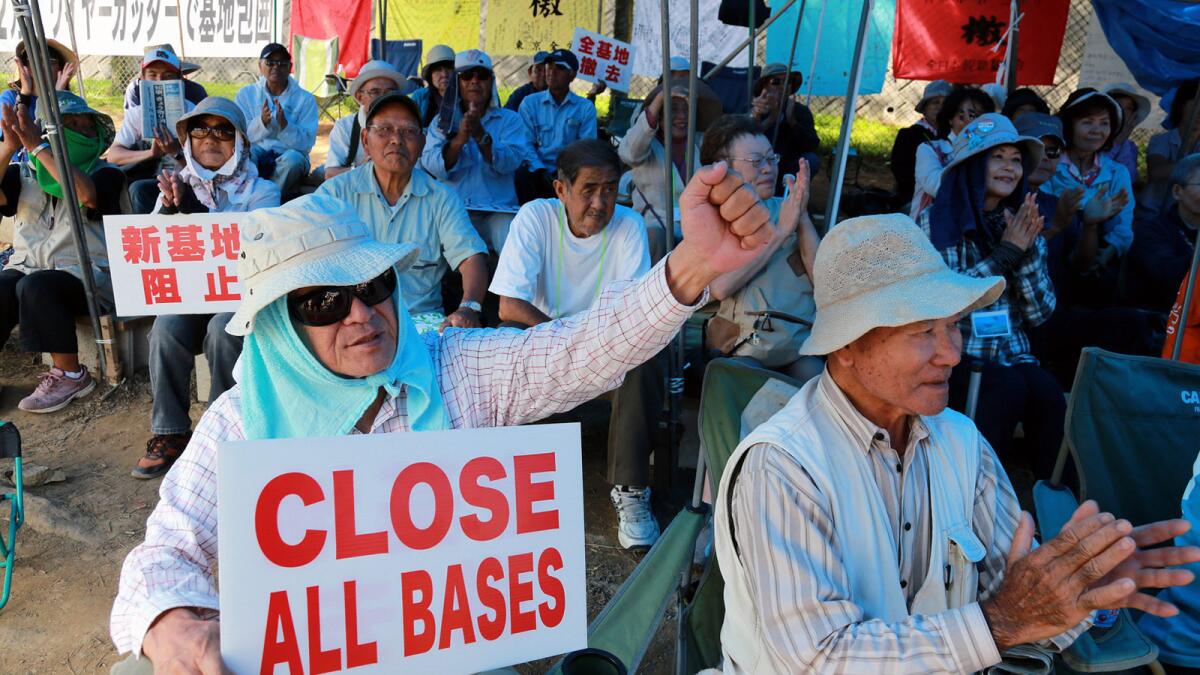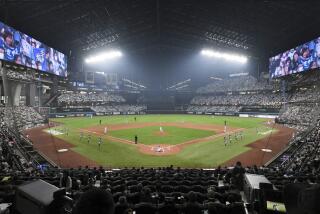Even as they fear China, Okinawans battle against U.S. bases in Japan

Protesters stage a demonstration outside the U.S. Marine Corps’ Camp Schwab on Okinawa island, southern Japan, on Monday.
- Share via
Reporting from Henoko, Japan — The white-sand beach is partitioned by a gray metal fence.
On the American side stands Camp Schwab, a sprawling, citadel-like compound perching on the expanse of the emerald bay; bursts of practice rounds ring out intermittently from the U.S. Marine Corps shooting range.
The patch of shore accessible to local Okinawans is fronted by a canopy sheltering demonstrators and a rain-battered sign reading “Day 4161.” Scrawled on the top of the tent: “USMC [is] harmful for security of Okinawa people.”
Prime Minister Shinzo Abe is pushing Japan to cooperate more closely with the U.S. armed forces in the face of an increasingly mighty China, which is flexing its muscles in the East and South China seas. This week, his ruling coalition is expected to push through parliament changes to the country’s pacifist constitution that would allow Japanese troops to be deployed beyond the national border for the first time since World War II and fight alongside Americans.
Situated on the southeastern edge of the Japanese archipelago, 1,000 miles from Tokyo and about the same distance from the Chinese mainland, Okinawa would be on the geographical frontlines in any conflict over the Senkaku islands, which are controlled by Japan but claimed by China (which calls them the Diaoyu islands).
Yet Okinawans continue to wage a lonely battle against the American military presence here.
U.S. military installations still take up one-fifth of the island, and nearly three-quarters of the more than 50,000 American troops in Japan are stationed here.
Last weekend, despite overwhelming local opposition led by Okinawa’s governor, national authorities resumed landfill preparation work to expand Camp Schwab to house the 3,000 Marines to be relocated from Futenma Air Base in south-central Okinawa.
“A majority of the people here say they’re afraid of China,” said Shino Hateruma, a prefectural researcher who has conducted opinion surveys here over the past two years, when the anti-base relocation campaign heated up. “But the best protection for them is keeping the peace. By opposing the relocation plans, they want to show they want to be peaceful neighbors to China.”
NEWSLETTER: Get the day’s top headlines from Times Editor Davan Maharaj >>
Economic concerns also are part of the debate. But Okinawans’ pacifist convictions have been forged both through bloodshed and decades living alongside a heavy American military presence. Among the staunchest anti-base demonstrators are elderly survivors of the Battle of Okinawa in March 1945, the largest single battle of the Pacific war. The fighting left 100,000 civilians dead — a third the island’s inhabitants.
Even after control over much of U.S.-occupied Japan was restored to Tokyo in 1951, American troops continued to administer the 460-square-mile island until 1972.
Since then, some former U.S. bases have been shuttered and redeveloped into shopping malls and amusement parks to lure Asian tourists eager for a taste of Americana closer to home.
Golf courses and resorts ring the pristine waters teeming with diverse, colorful species. Tourism accounted for more than a fifth of Okinawa’s GDP last year.
But tensions have persisted. In 1995, islanders were shocked and outraged by the gang rape of a pre-teen girl by U.S. servicemen; the fury was calmed by a promise to reduce troops in Okinawa and return the Futenma base — situated in a dense residential area — to local control for redevelopment.
The plan to relocate Futenma base is regarded by many Okinawans as a broken promise, because troops will just be moved, and there will be no reduction in troop numbers.
Locals also fear that the landfill for helipads and hangars at the relocated air base will choke off the sea life diversity important to the development of eco-tourism. One example is the endangered Okinawa dugong, a kind of manatee.
“The base will kill my business,” said Kazunari Nakasone, 36, operator of a kayak school nearby, who stopped by the demonstrators’ tent last week, while Tanaka Hiroyuki handed out thumb-sized origami manatees to supporters.
“Compared with a decade ago, more people are now joining the protest,” said Hiroyuki. “I think we’ll find a way to stop the construction. We’ll keep fighting in a nonviolent way.”
Nakasone and others periodically take to the bay at Henoko, steering their kayaks so as to obstruct construction work at Camp Schwab, and are increasingly confronted by the Coast Guard.
See the most-read stories this hour >>
Five years ago, anti-base Okinawans scored a victory when then-Prime Minister Yukio Hatoyama resigned over his failure to keep his promise to relocate the base off the island.
But a more assertive Abe government seems determined to keep the base on the island.
Even though Abe’s constitution reinterpretation efforts are hardly popular, few people on the main islands have rallied to Okinawans’ side. For most Japanese, Okinawa is a place apart.
Japan annexed Okinawa 60 years before WWII along with the Ryukyu island chain. Okinawa accounts for less than 1% of Japan’s landmass.
“The Japanese government has succeeded in making the people believe it’s American strategy to keep the base here and that Okinawa is fated to be used,” said Tomohiro Yara, a longtime local journalist and commentator on the Japan-U.S. security alliance. “But this is a democracy, so who decides to put the bases here? The current arrangement is very convenient for both Tokyo and Washington. The Japanese government must have total responsibility.”
Law is a special correspondent.
ALSO:
8.3 quake hits off northern Chile; jolt sways buildings and kills 8
For China’s Xi Jinping, strong trade ties ensure a warm welcome in Seattle
A high-speed rail from L.A. to Las Vegas? China says it’s partnering with U.S. to build
More to Read
Sign up for Essential California
The most important California stories and recommendations in your inbox every morning.
You may occasionally receive promotional content from the Los Angeles Times.












